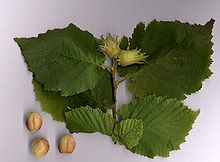Corylus avellana
| Corylus avellana | |
|---|---|
 |
|
| Common hazel leaves and nuts | |
| Scientific classification | |
| Kingdom: | Plantae |
| (unranked): | Angiosperms |
| (unranked): | Eudicots |
| (unranked): | Rosids |
| Order: | Fagales |
| Family: | Betulaceae or Corylaceae |
| Genus: | Corylus |
| Species: | C. avellana |
| Binomial name | |
|
Corylus avellana L. |
|
 |
|
| Distribution map | |
Corylus avellana, the common hazel, is a species of hazel native to Europe and western Asia, from the British Isles south to Iberia, Greece, Turkey and Cyprus, north to central Scandinavia, and east to the central Ural Mountains, the Caucasus, and northwestern Iran. It is an important component of the hedgerows that were the traditional field boundaries in lowland England. The wood was traditionally grown as coppice, the poles cut being used for wattle-and-daub building and agricultural fencing.
Common hazel is cultivated for its nuts. The name hazelnut applies to the nuts of any of the species of the genus Corylus. This hazelnut or cob nut, the kernel of the seed, is edible and used raw or roasted, or ground into a paste. The cob is round, compared with the longer filbert nut.
Common hazel is typically a shrub reaching 3–8 m tall, but can reach 15 m. The leaves are deciduous, rounded, 6–12 cm long and across, softly hairy on both surfaces, and with a double-serrate margin. The flowers are produced very early in spring, before the leaves, and are monoecious with single-sex wind-pollinated catkins. Male catkins are pale yellow and 5–12 cm long, while female catkins are very small and largely concealed in the buds with only the bright red 1–3 mm long styles visible. The fruit is a nut, produced in clusters of one to five together, each nut held in a short leafy involucre ("husk") which encloses about three quarters of the nut. The nut is roughly spherical to oval, 15–20 mm long and 12–20 mm broad (larger, up to 25 mm long, in some cultivated selections), yellow-brown with a pale scar at the base. The nut falls out of the involucre when ripe, about 7–8 months after pollination.
...
Wikipedia

